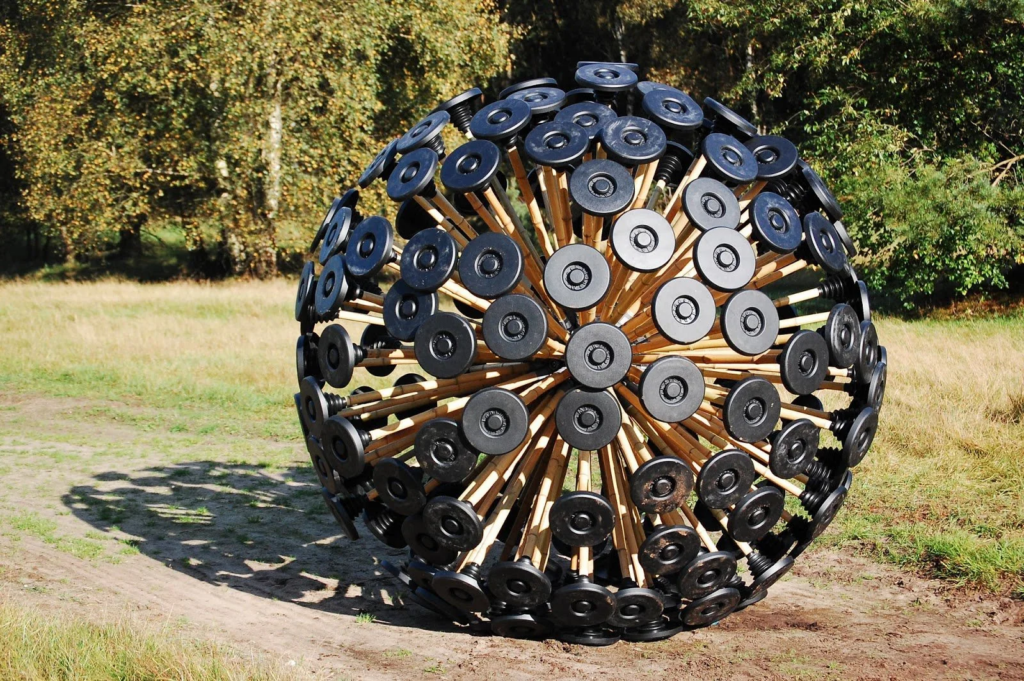
INTRODUCTION
Biodegradable land mines are a type of explosive device designed to degrade and dissolve over time after being deployed, eliminating the long-term environmental and humanitarian hazards associated with traditional land mines. Unlike conventional mines, which remain active for years or even decades after a conflict has ended, biodegradable mines automatically decompose or lose their functionality, preventing them from posing a threat to civilians, wildlife, and the environment after the conflict is over.
These innovative devices are part of a broader movement toward environmentally friendly and ethical military technologies, offering the potential to balance battlefield effectiveness with post-conflict ecological responsibility.
HOW DOES IT WORKS
Biodegradable land mines use materials that can degrade naturally over time. Their basic function and structure remain similar to traditional mines: they are designed to detonate upon pressure or remote activation. However, the key difference is that they contain materials—such as biodegradable polymers, natural fibers, or other non-toxic substances—that break down after a set period.
- Design Features:
- Degradable Shells: The outer casing of the mine may be made of biodegradable materials that weaken and break down after exposure to environmental factors like rain, heat, or humidity.
- Biodegradable Explosives: Instead of using synthetic, long-lasting explosives, the mine could incorporate compounds that degrade naturally after a certain period, reducing the chances of accidental detonation long after the battlefield has been cleared.
- Time-Controlled Activation: Some biodegradable mines could incorporate time-release mechanisms that deactivate the explosive after a predetermined period, ensuring they no longer pose a danger once the conflict is over.
- Degradation Mechanisms:
- Environmental Exposure: Mines designed with natural fibers or polymers would degrade through natural processes (e.g., microbial activity, moisture absorption, and sunlight exposure).
- Self-Destruction Mechanisms: Mines may include a self-detonation feature or a mechanism that renders the mine inert after a set amount of time, triggered by a simple environmental condition or mechanical failure.
ADVANTAGES OF BIODEGRADABLE LANDMINES
- Reduced Long-Term Threat:
- Traditional land mines remain a hazard long after a conflict has ended, leading to civilian casualties, economic costs, and humanitarian crises. Biodegradable mines degrade over time, reducing the risk to civilians, demining teams, and wildlife once the conflict has concluded.
- Environmental Impact:
- Conventional land mines, made from metals and plastics, can contaminate ecosystems and remain toxic for decades. Biodegradable mines, by contrast, are designed to break down into non-toxic substances, reducing environmental damage and helping to restore affected areas after the conflict.
- The use of sustainable, natural materials in the construction of biodegradable mines can help mitigate the environmental footprint of military operations.
- Ethical Considerations:
- The deployment of biodegradable land mines aligns with international efforts to limit the use of traditional mines, such as the Ottawa Treaty (Mine Ban Treaty), which seeks to eliminate land mines that continue to pose a threat long after the war is over. Biodegradable mines provide a compromise between the military need for area denial and the need to prevent future harm to civilians and the environment.
- Cost-Effectiveness:
- In the long run, biodegradable land mines could reduce the cost and labor associated with demining efforts, which are typically extensive, costly, and dangerous. The natural degradation of the mine eliminates the need for costly post-conflict clearance operations.
CHALLENGES AND LIMITATIONS
- Effectiveness in Combat:
- Biodegradable mines may not be as durable or effective as traditional mines in certain combat situations. Their degradation process could potentially render them less reliable in prolonged conflicts, especially in environments that do not favor natural degradation (e.g., arid regions or extreme temperatures).
- Some biodegradation processes may be slow, leading to mines that remain active for longer than desired. Finding the right balance between functionality and degradation is a key technical challenge.
- Deployment in Harsh Environments:
- Biodegradable materials are subject to degradation from environmental factors like moisture, temperature, and microorganisms. In extreme conditions, such as deserts or frozen landscapes, the degradation might not occur as expected, potentially leading to an extended threat from mines.
- Cost and Technological Complexity:
- Developing biodegradable land mines that are both effective and affordable may be challenging. New materials and technologies need to be tested and integrated into existing mine deployment systems, which could lead to higher development and production costs.
- International Regulation and Compliance:
- While biodegradable mines are a step toward more ethical land mine use, the introduction of such technologies could face resistance from countries or military forces concerned about their reliability and effectiveness. Balancing military utility with humanitarian concerns is an ongoing challenge.
APPLICATIONS
Applications of Biodegradable Land Mines:
- Defensive Operations:
- Biodegradable land mines could be used to temporarily secure a perimeter or deny access to an area in conflict zones, where clearing operations are not immediately feasible. After the conflict, the mines would degrade, ensuring the area is safe for civilians and reconstruction.
- Peacekeeping and Humanitarian Missions:
- In post-conflict zones, biodegradable mines could be deployed to secure areas temporarily, allowing peacekeeping forces to safely establish order without leaving a long-term threat to the population.
- Environmental Restoration:
- After a conflict, the use of biodegradable land mines can help minimize the need for extensive land restoration and demining operations, reducing the environmental and economic burden of clearing conventional mines.
- Urban Warfare:
- In urban environments, biodegradable mines could provide temporary protection or area denial while allowing for quicker post-conflict recovery, as there would be no need for traditional mine clearance teams to visit every urban block or building.
